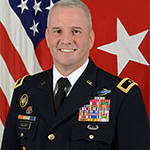Although it’s never had to deploy, DoD’s CBRN task force is national ‘insurance policy’
It’s a good bet that most Americans have never heard of the military’s Joint Task Force Civil Support. That’s due, in good measure, to the fortunate fact that...
Editor’s Note: This edition of On DoD also includes an interview with Jay Kaplan, the CEO of Synack, which recently won one of two contract awards to build the next round of “bug bounties” for the Pentagon.
It’s a good bet that most Americans have never heard of the military’s Joint Task Force Civil Support. That’s due, in good measure, to the fortunate fact that it’s never had to perform its primary mission during its 17 years in existence: deploying military forces to the site of a chemical, biological, radiological or nuclear (CBRN) disaster.

“We’re a national insurance policy, because all of us hope nothing like this would ever happen, but we can’t be caught unprepared if it did,” Maj. Gen. Richard Gallant, the task force’s commander said during a recent appearance on Federal News Radio’s On DoD. “We also have other capabilities. Because we’re constantly training, we’re also capable of responding to an all -hazards event.”
For example, during Hurricane Sandy in 2012, U.S. Northern Command, the Joint Task Force’s parent organization, designated it to coordinate the military’s support to civil authorities in New York and New Jersey.
As to its primary mission, although state first responders generally have equipment and expertise of their own to handle CBRN emergencies, the JTF’s main role would be to provide extra capacity if local officials were to be overwhelmed by the scale of an incident and a governor asked for assistance from the Pentagon.
“In the past 20 years we’ve seen an exponential growth in both capability and capacity at the city, county and the state level, but we also need to identify where the county managers and mayors and governors potentially have a gap that the Department of Defense would need to fill in,” Gallant said. “Seven days a week we’re planning and preparing, and we can’t do it in a vacuum. We have to work with the FEMA regions and the adjutant generals from the states on extensive tabletop exercises. FEMA is working on regional plan books in conjunction with the National Guard Bureau and NORTHCOM, so we are integral to that process so we can identify the specific gaps in the CBRN enterprise.”
In normal times, the Joint Task Force is a lean operation, consisting of just 180 people based at Ft. Eustis, Va. But if it were to be called into action, it would take charge of up to 5,200 troops – mostly Army soldiers – who are trained in CBRN response as a collateral duty and are stationed throughout the country.
“They would deploy out of, say, Fort Hood, and we also have units at Fort Bragg and Fort Lewis. So depending on where the event took place, we could have elements there providing critical lifesaving capability, mitigating suffering and providing that critical support within a matter of hours,” Gallant said. “Then, within a couple of hours, I have a 35 person command cell that would fly from Ft. Eustis to the incident site so we can minimize the amount of time that we’re unravelling on the incident site and get our people in to work with the incident commanders. Because if we’re all standing at a staging area, we’re not saving lives.”
In any case, the task force and the troops it commands would serve in a support function to the primary civilian agency – FEMA in most cases – partially because of the Posse Comitatus Act and its prohibition on Title 10 federal military forces acting in roles that resemble police functions on U.S. soil. All of the responders, including military ones, would report to a civilian incident commander.
And successfully blending those troops with local responders under a unified command with unity of effort also requires advance planning and cooperation, Gallant said.
“I’ve been doing this for 35 years, and I’ve been amazed at the improvement in our ability to talk to our civilian partners over the past four or five years,” he said. “We don’t always speak the same language, but we’re getting better. It’s been a dream of mine for years to have everyone using the same computer and communications systems with a common operating picture. That’s never going to happen. In the end, it’s about having access to the same information at the same time in a format that we can all read, because it only speeds up these operations.”
Copyright © 2025 Federal News Network. All rights reserved. This website is not intended for users located within the European Economic Area.
Jared Serbu is deputy editor of Federal News Network and reports on the Defense Department’s contracting, legislative, workforce and IT issues.
Follow @jserbuWFED




